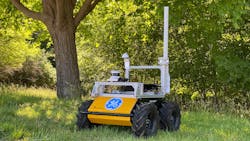Humble AI Steers UGV Through Rough Terrain
U.S. Army researchers recently tested an unmanned ground vehicle (UGV) from GE Research that's capable of deciding on the best travel path through rugged, unstructured terrain. The prototype autonomous system is equipped with GE’s so-called Humble artificial-intelligence (AI) technology for an awareness of risk if traveling different paths.
The Humble AI technology is an attempt to make a robotic system more human by giving it a sense of its own limitations and capabilities, a sense of humility. The Humble AI software has been applied by many renewable energy companies for cost-effective management of wind turbines.
The intelligent UGV (see figure) was developed by the GE Research Robotics Team, led by Senior Robotics Scientist Shiraj Sen during the first year of the Scalable Adaptive Resilient Autonomy (SARA) program with the U.S. Army. “One of the big challenges with autonomous systems is overcoming the risk factor, particularly when it involves equipment for complex military operations or critical infrastructure where safety and reliability are most important,” said Sen.
He added, “with the successful demonstration of our ‘risk-aware’ autonomous ground vehicle in our project with the Army we’ve made progress in removing some of those risks and, hopefully, provided a clearer path to more autonomous systems applications further down the road…or off road.”
Eric Spero, SARA Program Manager, noted, “In future Army scenarios, autonomous systems will have to reliably plan in the presence of challenging features they encounter while maneuvering in complex terrain. Incorporating risk and uncertainty into the autonomy decision-making process enables our testbed platforms to show us what it looks like to plan a direct path instead of taking the long way around.” The project was funded by the U.S. Army’s Combat Capabilities Development Command Army Research Laboratory (ARL) as part of the Army’s commitment to autonomous robotics technology.
About the Author
Jack Browne
Technical Contributor
Jack Browne, Technical Contributor, has worked in technical publishing for over 30 years. He managed the content and production of three technical journals while at the American Institute of Physics, including Medical Physics and the Journal of Vacuum Science & Technology. He has been a Publisher and Editor for Penton Media, started the firm’s Wireless Symposium & Exhibition trade show in 1993, and currently serves as Technical Contributor for that company's Microwaves & RF magazine. Browne, who holds a BS in Mathematics from City College of New York and BA degrees in English and Philosophy from Fordham University, is a member of the IEEE.
